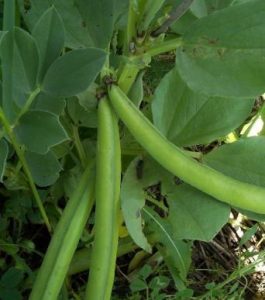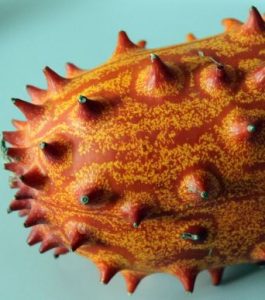 Common Name:Acacia (Apple-ring)
Common Name:Acacia (Apple-ring)
Description
Faidherbia albida is one of the largest thorn trees, reaching 30 m in height, with spreading branches and a rounded crown. Bark rough and dark brown, or smooth and greenish-grey; young branches white to ashy grey and characteristically zigzag in shape. Stipules spinescent, straight, about 2 cm long, creamy coloured with brown tips. Slash fibrous, pink to light brown. The roots can grow to 40 m deep.
Leaves with 3-10 pairs of pinnae, each bearing 6-23 pairs of leaflets; leaflets quite large, 3.5-9 x 0.7-3 mm, grey-green. Modified spiny stipules at the base of the leaves, thickened at the base, straight and robust. (The basal thickening is a characteristic distinguishing. ..…Read more
References
Switchboard
Wikipedia
Meet the crops
Ximenia caffra
 Common Name: Sour plum
Common Name: Sour plum
Description
Ximenia caffra is a sparsely branched shrub or small tree to 6 m tall with a shapeless, untidy crown. Branches and twigs are armed with stout axillary spines and are glabrous or dense tomentose. Bark is grayish-brown to black, longitudinally fissured bark, red slash and rough on older, larger species.
Leaves simple, alternate, elliptic to lanceolate, 2.5-9 cm long by 1.2-5 cm wide, leathery, blue-green, often fascicled on dwarf, lateral shoots, margin entire, apex rounded or notched, base broadly tapering to rounded, often hairy when young and turning to shiny green when getting older and petiole about 8 mm long. . . . .Read more
References
ICRAF Switchboard
Wikipedia
Vicia faba
 Common Name: Favabean
Common Name: Favabean
Description
Vicia faba, also known as the broad bean, fava bean, faba bean, field bean, bell bean, English bean, horse bean, Windsor bean, pigeon bean and tic(k) bean, is a species of flowering plant in the vetch and pea family Fabaceae. The origin of this legume is obscure, but it had been cultivated in the Middle East for 8,000 years before it spread to Western Europe. Fava or Broad beans have been found in the earliest human settlements. Remains are reported to have been found in Egyptian tombs.[citation needed] They probably originated in the Near East during the Neolithic Age and by the Bronze Age had spread to Northern Italy. They have been found in lakeside settlements in Switzerland and in Britain at Glastonbury. In Egypt, the beans were considered commoner food and were shunned by the upper classes. Fava beans were cultivated by the Egyptians, Greeks and Romans. In ancient Rome, they were used in funeral rites. Pythagoras forbade the eating of fava beans because they contained the souls of the dead. This once forbidden . . . . .Read more
References
Switchboard
Wikipedia
Cucumis metuliferus
 Common Name: Horned Melon
Common Name: Horned Melon
Description
Cucumis metuliferus, horned melon or kiwano, also African horned cucumber or melon, jelly melon, hedged gourd, melano, in the southeastern United States, blowfish fruit, is an annual vine in the cucumber and melon family, Cucurbitaceae. Its fruit has horn-like spines, hence the name “horned melon”. Ripe fruit has yellow-orange skin and lime green, jelly-like flesh with a tart taste, and texture similar to a cucumber. C. metuliferus is native to Sub-Saharan Africa. It is now grown in California, Mississippi, Chile, Australia, and New Zealand. . . . .Read more
References
Switchboard
Wikipedia